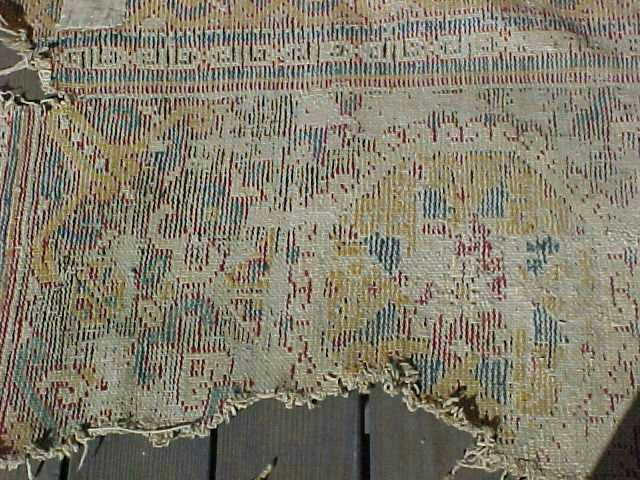
A dozen or so people found their way to Jim Dixon's house in Kensington where his collection of Japanese Kesa (priest robes) were on view. Among those attending were Diane Mott, assistant curator of textiles at the de Young Museum, Susan York, Arthur Leeper, Joyce Hulbert, textile artist, and SFBARS editor, Peter Lyman. The shimmering quality of these brocades provided a visual delight.
SFBARS members discussed whether or not the Kesa corner square inserts usually found in colors that contrast with the panel strips, come from older robes, perhaps those of senior monks. Downstairs in the music room nearly a dozen prayer rugs from Mudjur and Ladik were on display. It is not unusual to see a single old Mudjur or Ladik in a collection, but to be able to see a group of them where one can compare their various individual motifs is a special pleasure.
Of special significance to the rug community are two curious fragments which our host brought out still later in the evening. These appear at first glance to resemble Fostat fragments. [see Carl Lamm's book on the subject Carpet Fragments ] A number of these curious and ancient "Fostat" carpet fragments were purchased by Carl Lamm from "antiquity dealers" in Cairo who, according to Lamm, asserted they were found at al-Fostat (Old Cairo)--probably dug from ancient rubbish heaps. They are a particularly interesting group most dating from the 8th to 15 c.
Both Dixon fragments have remnants of a "large pattern Holbein" octagon (one outlined in gold, and one in white). Different colored octagon surrounds indicate these fragments probably come from two individual small rugs. They were both found in Tibet. Arabesques, remnants of a secondary gul, grace the corners adjacent to the octagons. These recall the outward extensions of the minor guls of a rare type of "small pattern Holbein" carpet (see the "chair fragments" fig 49 in Kurt Erdmann's Seven Hundred Years of Oriental Carpets),--a rare admixture of the two early 15th c. Turkish "Holbein" designs. A form of this unusal design combination can also be seen in the so-called "Beysehir" mosque rug now in the Mevlana Museum in Konya--a rug considered to be a Holbein prototype. [Erdmann fig 44 or Oktay Aslanapa, One Thousand Years of Turkish Carpets, Pl 45].
Two of the Fostat fragments, #'s 26 and #27 also possess a similar layout found in the Beysehir prototype rug. The border of each of the Dixon fragments is composed of a complex tri-colored interlocking S motif, an unusual border which also appears in one of the minor borders of a rug from the Ulu Mosque, Divrigi [see pl 2 in Carpets of the Vakiflar Museum Istanbul by Belkis Balpinar and Udo Hirsch.] This rug the authors date to the 13th c. A close up of this border can be seen in Volkmar Gantzhorn's The Christian Oriental Carpet ill. 130. Gantzhorn dates this rug to the 12th centery.
It is significant that the Dixon fragments are woven with an asymmetrical knot which is unlike the usual symmetrical knot found in Holbein rugs. The only other examples which generally combine Turkish "Holbein" designs with the asymmetrical knots are the so-called "Para-Mamluk" rugs. [See Charles Grant Ellis' Oriental Carpets in the Philadelphia Museum of Art. or Gantzhorn ill 327.] Three of the Lamm Fostat fragments (one with a cufic "flag" border seen in the earliest of the small pattern Holbein rugs) also have asymmetrical knot (# 18, 19, and 28) and they, like the para Mamluks share the technical feature of being woven with the "Mamluk" counter- clockwise warp ply.
Unlike the Para Mamluk rugs, however, which invariably have red wool weft and the counter-clockwise warp ply, the Dixon fragments have white cotton weft and the standard clockwise warp ply. And unlike the Fostat fragments and Holbein rugs, which mostly have 2 and 3 ply woolen warps, the Dixon fragments have mostly 5 ply cotton warp, more characteristic of Chinese or East Turkestan rugs. There are an occasional 2ply woolen warps mixed in with the cotton, however. The question arises whether these asymmetrically knotted Fostat fragments and the Dixon fragments might be local copies, made in Egypt and Tibet respectively, of Turkish "Holbein" rugs. Or might they be precursors to the classic rugs? And what is their age? Everyone agreed the pieces should be carbon dated. Arguing for a very early date is the proto-Holbein format and the complex tri-colored S border.
Hillary Dumas
